Performance Evaluation of Steel Slag Asphalt Mixtures for Sustainable Road Pavement Rehabilitation
Abstract
1. Introduction
2. Materials and Methods
2.1. Materials and Specimen Preparation
2.2. Test Methods
3. Results and Discussion
3.1. Affinity between Aggregate and Binder
3.2. Marshall and Volumetric Properties
3.3. Stiffness and Fatigue Resistance
3.4. Permanent Deformation
3.5. Water Sensitivity
4. Conclusions
Author Contributions
Funding
Acknowledgments
Conflicts of Interest
References
- Bamigboye, G.; Bassey, D.; Olukanni, D.; Ngene, B.; Adegoke, D.; Odetoyan, A.; Kareem, M.; Enabulele, D.; Nworgu, A. Waste materials in highway applications: An overview on generation and utilization implications on sustainability. J. Clean. Prod. 2021, 283, 124581. [Google Scholar] [CrossRef]
- Gomes Correia, A.; Winter, M.G.; Puppala, A.J. A review of sustainable approaches in transport infrastructure geotechnics. Transp. Geotech. 2016, 7, 21–28. [Google Scholar] [CrossRef]
- Euroslag (The European Association Representing Metallurgical Slag Producers and Processors). Statistics 2018, 2022. Germany. Available online: https://www.euroslag.com/wp-content/uploads/2022/04/Statistics-2018.pdf (accessed on 1 November 2022).
- FHWA (Federal Highway Administration). User Guidelines for Waste and Byproduct Materials in Pavement Construction. Publication Number: FHWA-RD-97-148; 2022. Available online: https://www.fhwa.dot.gov/publications/research/infrastructure/structures/97148/ssa1.cfm (accessed on 1 November 2022).
- CEN. EN 13242+A1—Aggregates for Unbound and Hydraulically Bound Materials for Use in Civil Engineering Work and Road Construction; European Committee for Standardization: Brussels, Belgium, 2007. [Google Scholar]
- Correia, A.G.; Roque, A.J.; Ferreira, S.M.R.; Fortunato, E. Case Study to Promote the Use of Industrial Byproducts: The Relevance of Performance Tests. J. ASTM Int. 2012, 9, 1–18. [Google Scholar]
- Piatak, N.; Parsons, M.; Seal, R., II. Characteristics and environmental aspects of slag: A review. Appl. Geochem. 2015, 57, 36–266. [Google Scholar] [CrossRef]
- Skaf, M.; Manso, J.; Aragón, A.; Fuente-Alonso, J.; Ortega-López, V. EAF slag in asphalt mixes: A brief review of its possible re-use. Resour. Conserv. Recycl. 2017, 120, 176–185. [Google Scholar] [CrossRef]
- Sorlini, S.; Sanzeni, A.; Rondi, L. Reuse of steel slag in bituminous paving mixtures. J. Hazard. Mater. 2012, 209–210, 84–91. [Google Scholar] [CrossRef] [PubMed]
- Gokalp, I.; Uz, V.; Saltan, M.; Tutumluer, E. Technical and environmental evaluation of metallurgical slags as aggregate for sustainable pavement layer applications. Transp. Geotech. 2018, 14, 61–69. [Google Scholar] [CrossRef]
- Loureiro, C.D.A.; Moura, C.F.N.; Rodrigues, M.; Martinho, F.C.G.; Silva, H.M.R.D.; Oliveira, J.R.M. Steel slag and recycled Concrete aggregates: Replacing quarries to supply sustainable materials for the asphalt paving industry. Sustainability 2022, 14, 5022. [Google Scholar] [CrossRef]
- Gulisano, F.; Crucho, J.; Gallego, J.; Picado-Santos, L. Microwave Healing Performance of Asphalt Mixture Containing Electric Arc Furnace (EAF) Slag and Graphene Nanoplatelets (GNPs). Appl. Sci. 2020, 10, 1428. [Google Scholar] [CrossRef]
- Gulisano, F.; Buasiri, T.; Apaza, F.; Cwirzen, A.; Gallego, J. Piezoresistive Behavior of Electric Arc Furnace Slag and Graphene Nanoplatelets Asphalt Mixtures for Self-Sensing Pavements. Autom. Constr. 2022, 142, 104534. [Google Scholar] [CrossRef]
- Jiao, W.; Sha, A.; Liu, Z.; Jiang, W.; Hu, L.; Li, X. Utilization of steel slags to produce thermal conductive asphalt concretes for snow melting pavements. J. Clean. Prod. 2020, 261, 121197. [Google Scholar] [CrossRef]
- Ameri, M.; Hesami, S.; Goli, H. Laboratory evaluation of warm mix asphalt mixtures containing electric arc furnace (EAF) steel slag. Constr. Build. Mater. 2013, 49, 611–617. [Google Scholar] [CrossRef]
- Chen, Z.; Wu, S.; Wen, J.; Zhao, M.; Yi, M.; Wan, J. Utilization of gneiss coarse aggregate and steel slag fine aggregate in asphalt mixture. Constr. Build. Mater. 2015, 93, 911–918. [Google Scholar] [CrossRef]
- Chen, Z.; Leng, Z.; Jiao, Y.; Xu, F.; Lin, J.; Wang, H.; Cai, J.; Zhu, L.; Zhang, N.; Dong, Y.; et al. Innovative use of industrially produced steel slag powders in asphalt mixture to replace mineral fillers. J. Clean. Prod. 2022, 344, 131124. [Google Scholar] [CrossRef]
- Fakri, M.; Ahmadi, A. Recycling of RAP and steel slag aggregates into the warm mix asphalt: A performance evaluation. Constr. Build. Mater. 2017, 147, 630–638. [Google Scholar] [CrossRef]
- Fakri, M.; Ahmadi, A. Evaluation of fracture resistance of asphalt mixes involving steel slag and RAP: Susceptibility to aging level and freeze and thaw cycles. Constr. Build. Mater. 2017, 157, 748–756. [Google Scholar] [CrossRef]
- Martinho, F.; Picado-Santos, L.; Capitão, S. Influence of recycled concrete and steel slag aggregates on warm-mix asphalt properties. Constr. Build. Mater. 2018, 285, 684–696. [Google Scholar] [CrossRef]
- Massoudi, S.; Abtahi, S.; Goli, A. Evaluation of electric arc furnace steel slag coarse aggregate in warm mix asphalt subjected to long-term aging. Constr. Build. Mater. 2017, 135, 260–266. [Google Scholar] [CrossRef]
- Zhao, X.; Sheng, Y.; Lv, H.; Jia, H.; Liu, Q.; Ji, X.; Xiong, R.; Meng, J. Laboratory investigation on road performances of asphalt mixtures using steel slag and granite as aggregate. Constr. Build. Mater. 2022, 315, 125655. [Google Scholar] [CrossRef]
- Chen, J.; Wei, S. Engineering properties and performance of asphalt mixtures incorporating steel slag. Constr. Build. Mater. 2016, 128, 148–153. [Google Scholar] [CrossRef]
- Goli, A. The study of the feasibility of using recycled steel slag aggregate in hot mix asphalt. Case Stud. Constr. Mater. 2022, 16, e00861. [Google Scholar] [CrossRef]
- Neves, J.; Crucho, J.; Picado Santos, L.; Martinho, F. The influence of processed steel slag on the performance of a bituminous mixture. In Proceedings of the Ninth International Conference on Bearing Capacity of Roads, Railways and Airfields, Trondhein, Norway, 25–27 June 2013; pp. 617–625. [Google Scholar]
- Pasetto, M.; Baldo, N. Mix design and performance analysis of asphalt concretes with electric arc furnace slag. Constr. Build. Mater. 2011, 25, 3458–3468. [Google Scholar] [CrossRef]
- Xie, J.; Chen, J.; Wu, S.; Lin, J.; Wei, W. Performance characteristics of asphalt mixture with basic oxygen furnace slag. Constr. Build. Mater. 2013, 38, 796–803. [Google Scholar] [CrossRef]
- Xie, J.; Wu, S.; Lin, J.; Cai, J.; Chen, Z.; Wei, W. Recycling of basic oxygen furnace slag in asphalt mixture: Material characterization & moisture damage investigation. Constr. Build. Mater. 2012, 36, 467–474. [Google Scholar]
- Xie, J.; Wu, S.; Zhang, L.; Xiao, Y.; Liu, Q.; Yang, C.; Nie, S. Material characterization and performance evaluation of asphalt mixture incorporating basic oxygen furnace slag (BOF) sludge. Constr. Build. Mater. 2017, 147, 362–370. [Google Scholar] [CrossRef]
- Alves, R.; Rios, S.; Fortunato, E.; Viana da Fonseca, A. Mechanical Behaviour of Steel Slag-Rubber Mixtures: Laboratory Assessment. Sustainability 2023, 15, 1563. [Google Scholar] [CrossRef]
- Martinho, F.; Picado-Santos, L.; Capitão, S. Feasibility Assessment of the Use of Recycled Aggregates for Asphalt Mixtures. Sustainability 2018, 10, 1737. [Google Scholar] [CrossRef]
- IP. Specifications; Portuguese Infrastructure Agency: Almada, Portugal, 2014. [Google Scholar]
- EN 12697-30; Bituminous Mixtures—Test Methods for Hot Mix Asphalt—Part 30: Specimen Prepared by Impact Compactor. European Committee for Standardization: Brussels, Belgium, 2012.
- EN 12697-33; Bituminous Mixtures—Test Methods for Hot Mix Asphalt—Part 33: Specimen Prepared by Roller Compactor. European Committee for Standardization: Brussels, Belgium, 2019.
- EN 12697-11; Bituminous Mixtures—Test Methods for Hot Mix Asphalt—Part 11: Determination of the Affinity between Aggregate and Bitumen. European Committee for Standardization: Brussels, Belgium, 2020.
- EN 12697-34; Bituminous Mixtures—Test Methods for Hot Mix Asphalt—Part 34: Marshall Test. European Committee for Standardization: Brussels, Belgium, 2007.
- EN 12697-6; Bituminous Mixtures—Test Methods for Hot Mix Asphalt—Part 6: Determination of Bulk Density of Bituminous Specimens. European Committee for Standardization: Brussels, Belgium, 2020.
- EN 12697-5; Bituminous Mixtures—Test Methods for Hot Mix Asphalt—Part 5: Determination of the Maximum Density. European Committee for Standardization: Brussels, Belgium, 2017.
- EN 12697-8; Bituminous Mixtures—Test Methods for Hot Mix Asphalt—Part 8: Determination of Void Characteristics of Bituminous Specimens. European Committee for Standardization: Brussels, Belgium, 2018.
- EN 12697-26; Bituminous Mixtures—Test Methods for Hot Mix Asphalt—Part 26: Stiffness. European Committee for Standardization: Brussels, Belgium, 2018.
- EN 12697-24; Bituminous Mixtures—Test Methods for Hot Mix Asphalt—Part 24: Resistance to Fatigue. European Committee for Standardization: Brussels, Belgium, 2018.
- EN 12697-22; Bituminous Mixtures—Test Methods for Hot Mix Asphalt—Part 22: Wheel Tracking. European Committee for Standardization: Brussels, Belgium, 2020.
- EN 12697-23; Bituminous Mixtures—Test Methods for Hot Mix Asphalt—Part 23: Determination of the Indirect Tensile Strength of Bituminous Specimens. European Committee for Standardization: Brussels, Belgium, 2017.
- EN 12697-12; Bituminous Mixtures—Test Methods for Hot Mix Asphalt—Part 12: Determination of the Water Sensitivity of Bituminous Specimens. European Committee for Standardization: Brussels, Belgium, 2018.
- Porot, L.; Soenen, H.; Apeagyei, A.; Grenfell, J.; Vansteenkiste, S.; Chailleux, E. Recommendation of RILEM TC 237-SIB on affinity between aggregates and bituminous binders. Mater. Struct. 2018, 51, 173. [Google Scholar] [CrossRef]
- Crucho, J.; Neves, J.; Capitão, S.; Picado-Santos, L. Mechanical performance of asphalt concrete modified with nanoparticles: Nanosilica, zero-valent iron and nanoclay. Constr. Build. Mater. 2018, 181, 309–318. [Google Scholar] [CrossRef]
- Nicula, L.; Corbu, O.; Iliescu, M.; Dumitras, D. Using the blast furnace slag as alternative source in mixtures for the road concrete for a more sustainable and a cleaner environment. Rom. J. Mater. 2020, 50, 545–555. [Google Scholar]
- Li, C.; Chen, Z.; Wu, S.; Li, B.; Xie, J.; Xiao, Y. Effects of steel slag fillers on the rheological properties of asphalt mastic. Constr. Build. Mater. 2017, 145, 383–391. [Google Scholar] [CrossRef]

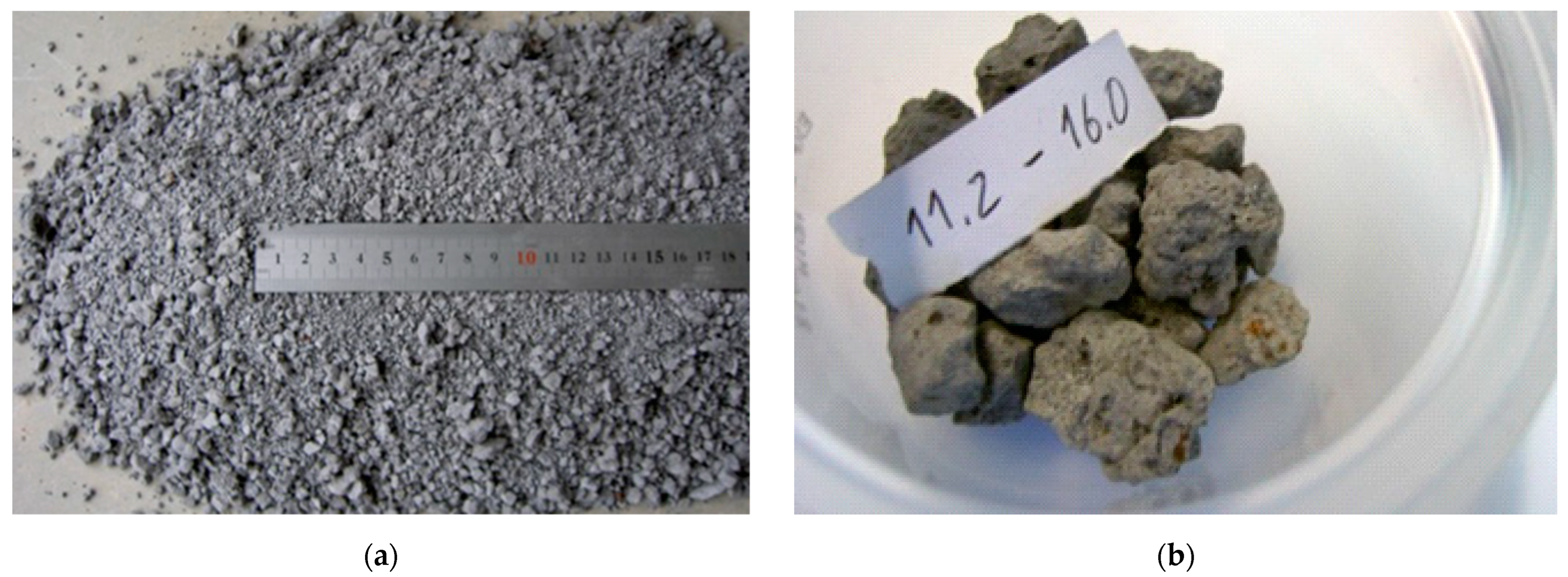
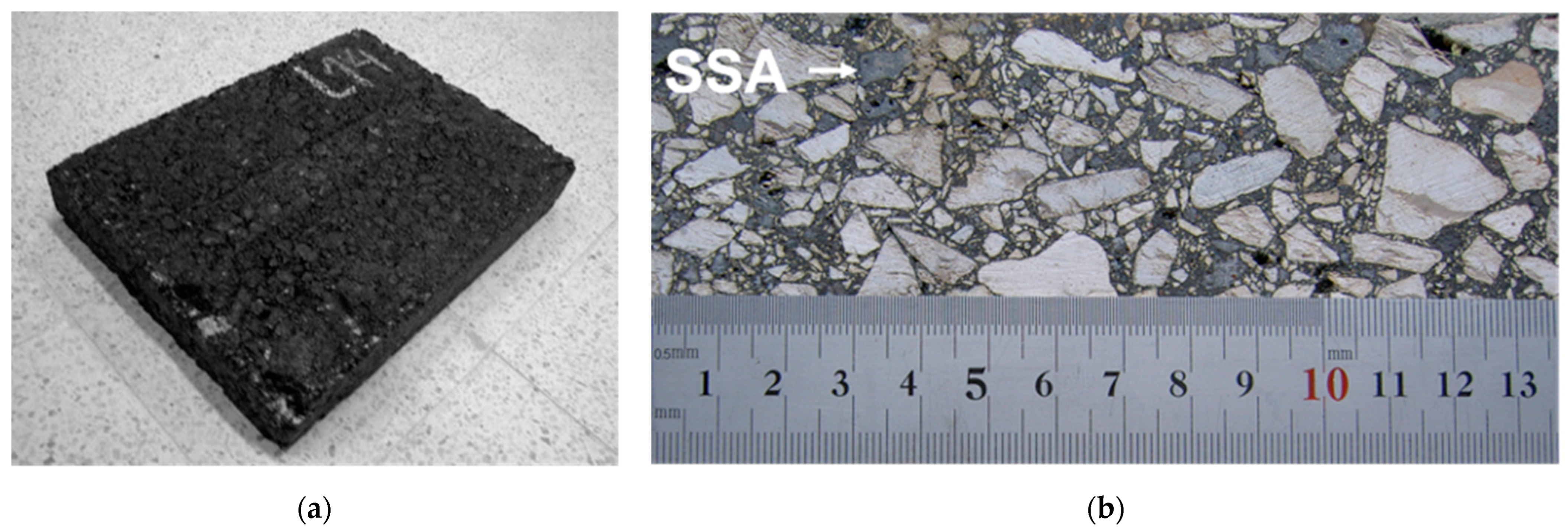
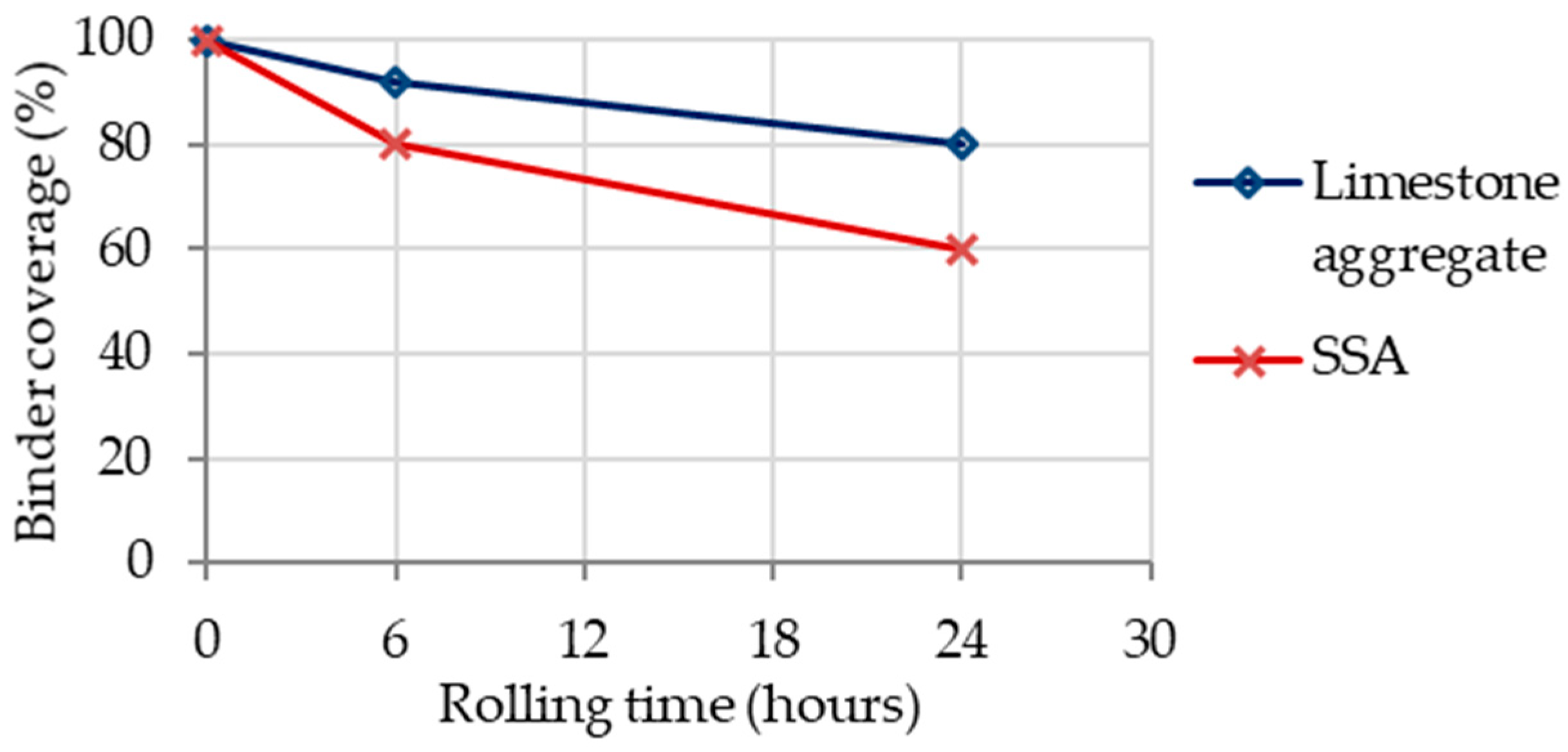
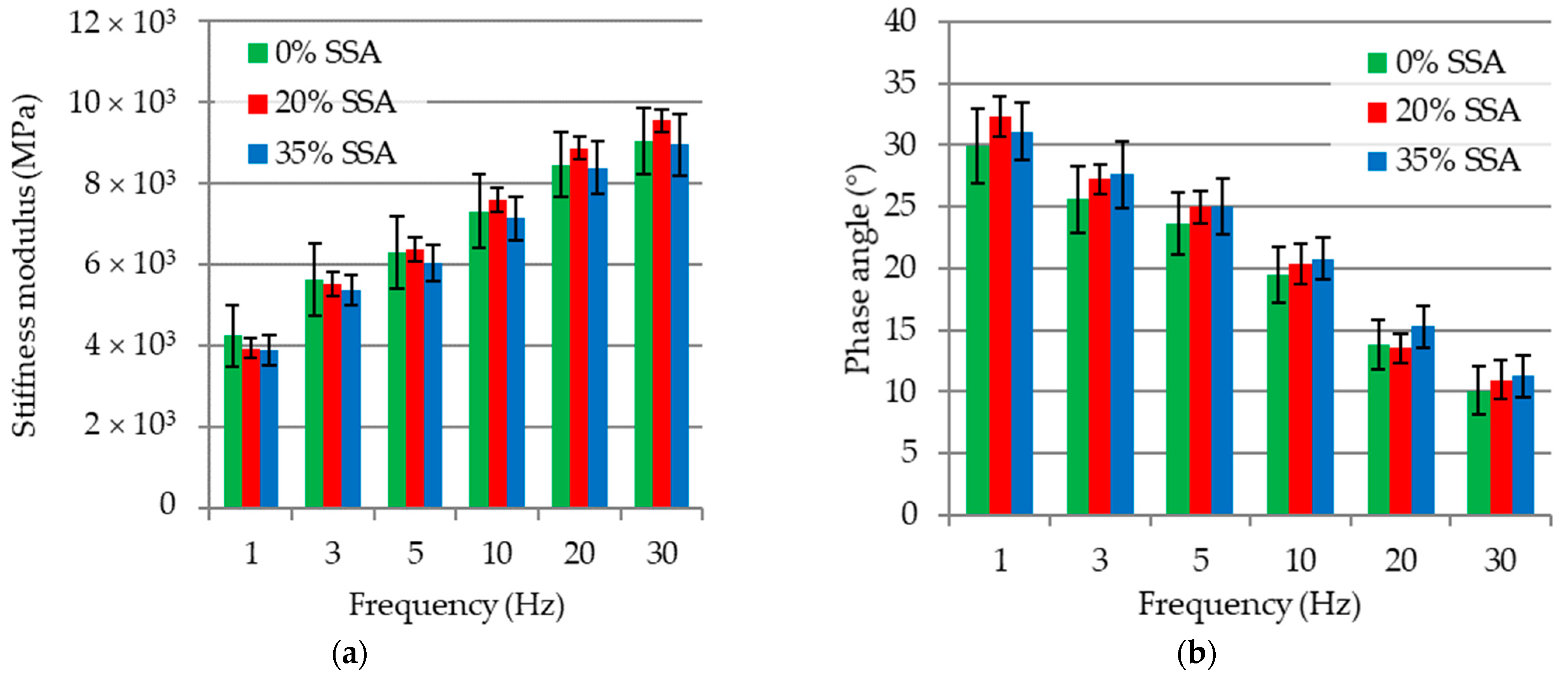
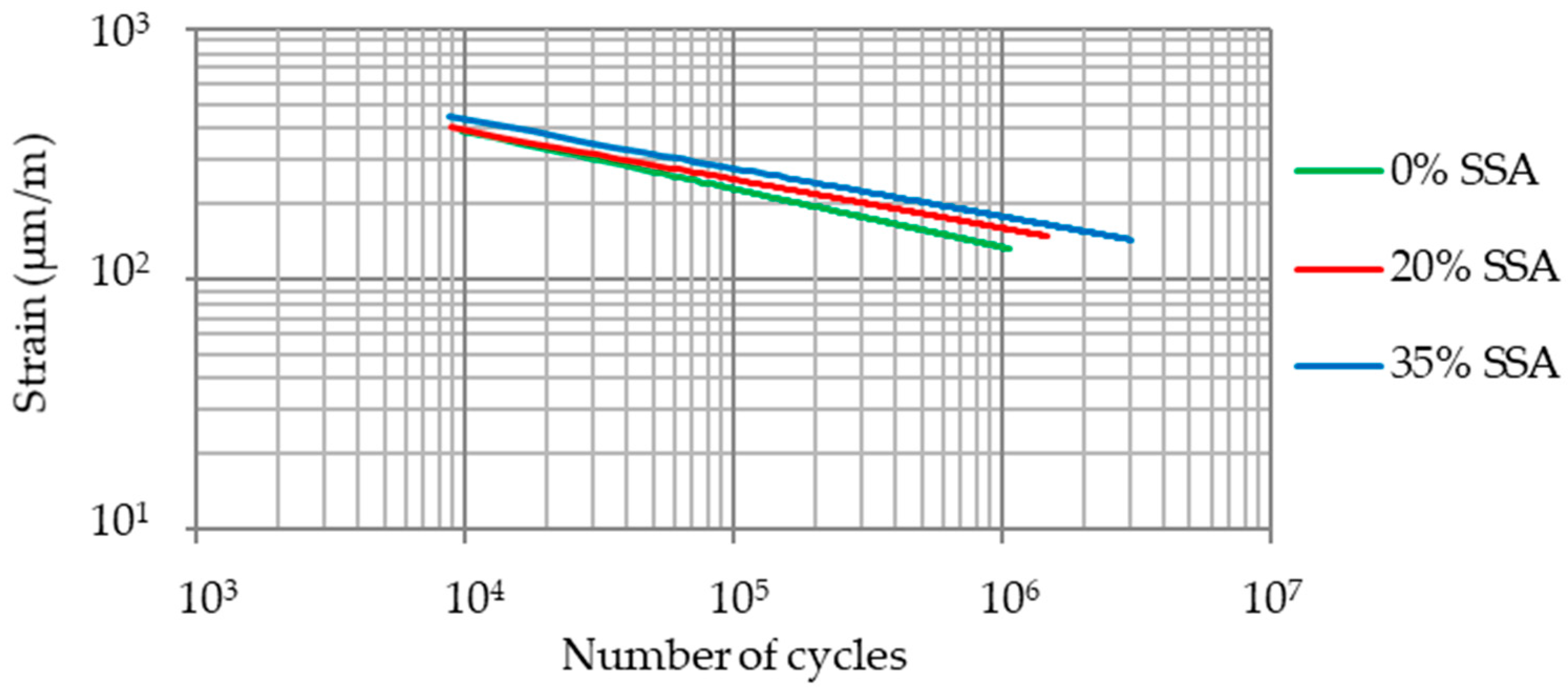
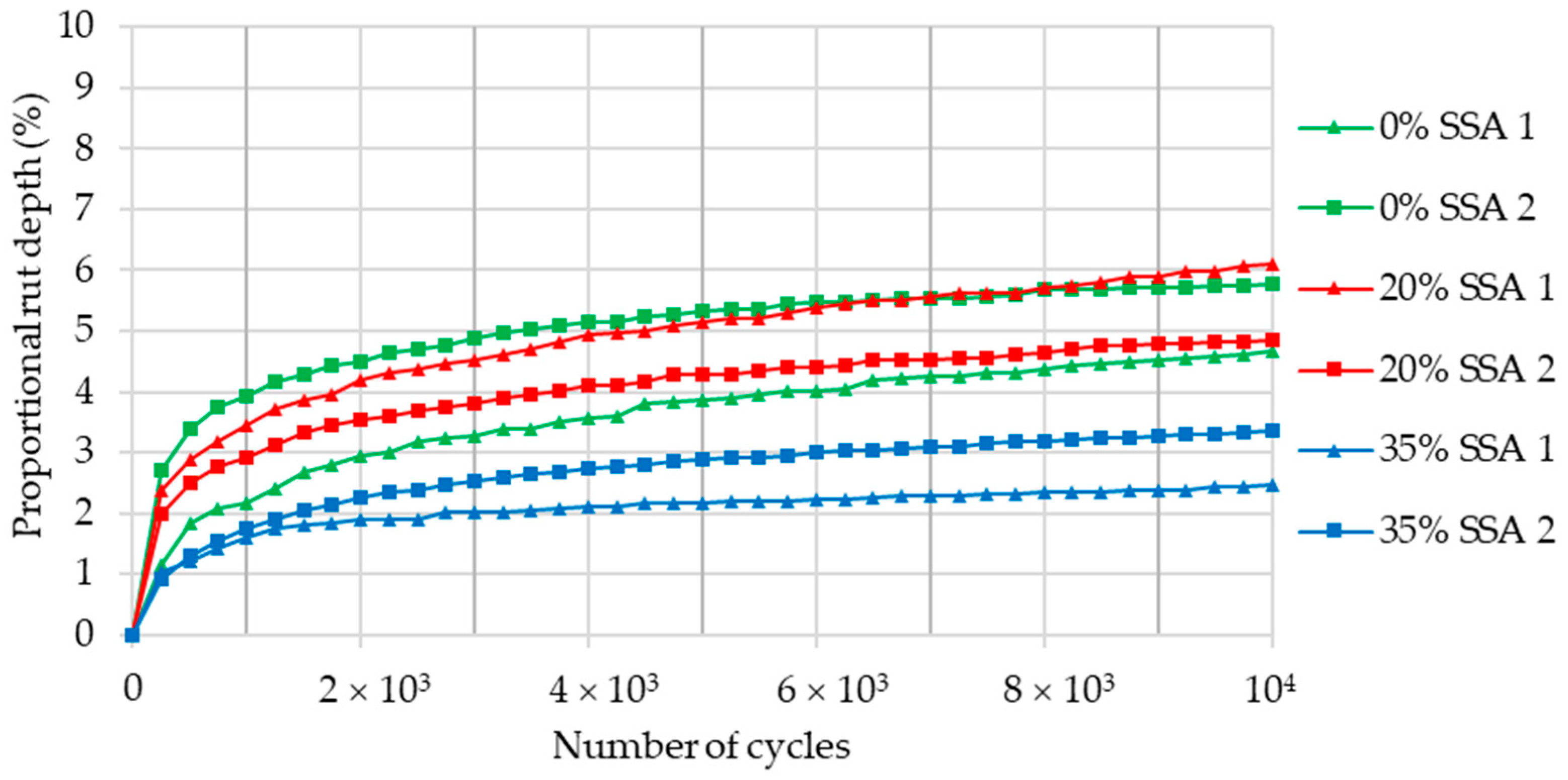
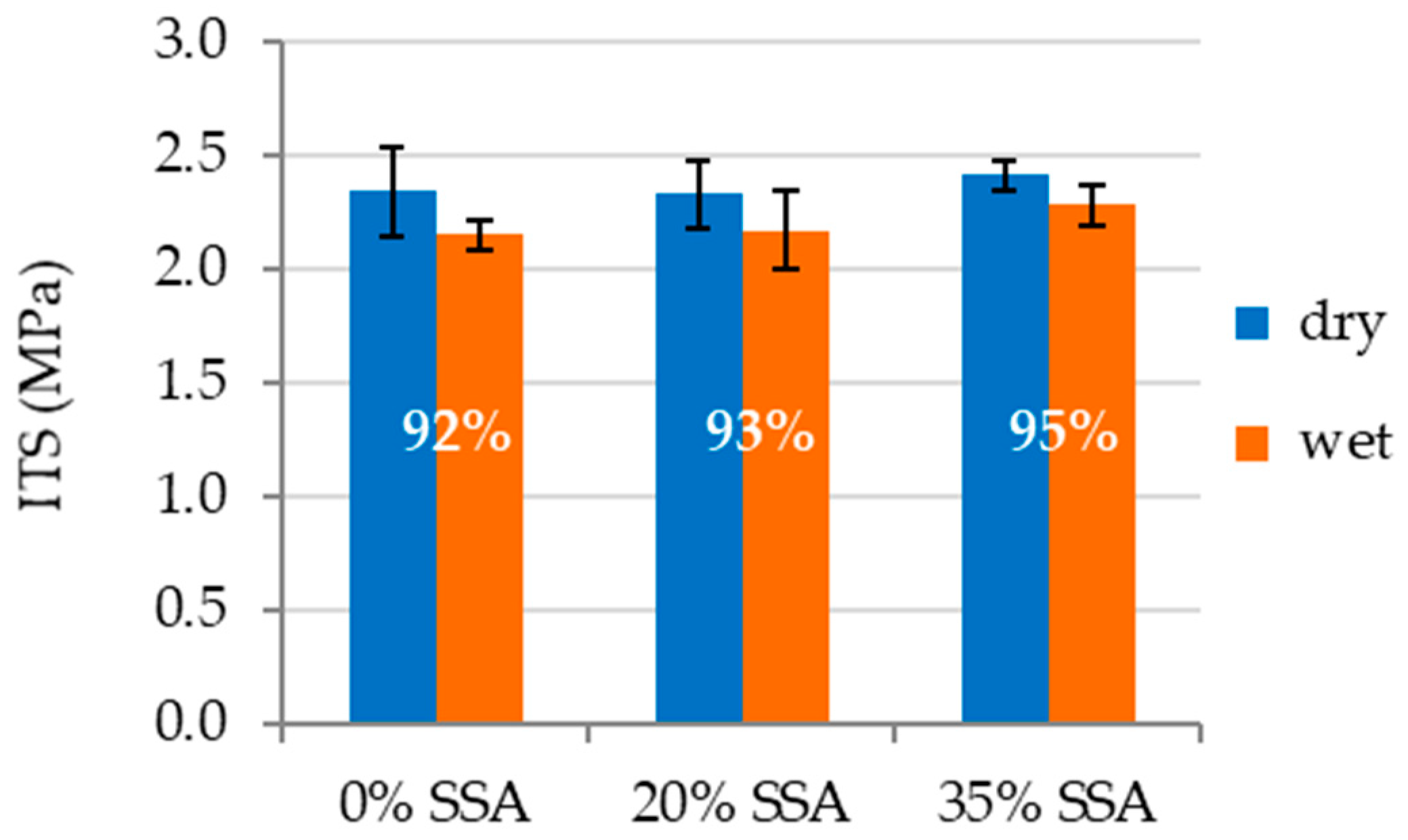
| Property | NA | SSA |
|---|---|---|
| Apparent particle density (Mg/m3) | 2.694 | 3.689 |
| Particle density on an oven-dried basis (Mg/m3) | 2.619 | 3.530 |
| Particle density on a saturated and surface-dried basis of aggregate (Mg/m3) | 2.647 | 3.573 |
| Water absorption (%) | 1.1 | 1.2 |
| Resistance to fragmentation by the Los Angeles test method (LA) | 30 | 25 |
| Methylene blue (g/kg) | 1.0 | 0.2 |
| Sand equivalent (SE) | 39 | 78 |
| Flakiness index (FI) | 11 | 1 |
| Shape index (SI) | 10 | 2 |
| Asphalt Mixture | NA | SSA | Filler | Bitumen |
|---|---|---|---|---|
| 0% SSA | 90.53 | 0.00 | 4.77 | 4.70 |
| 20% SSA | 71.47 | 19.06 | 4.77 | 4.70 |
| 35% SSA | 57.28 | 33.42 | 4.77 | 4.53 |
| Property | Asphalt Mixture | ||
|---|---|---|---|
| 0% SSA | 20% SSA | 35% SSA | |
| Binder content (% by mass) | 4.70 | 4.70 | 4.53 |
| Binder content (% by volume) | 10.81 | 11.47 | 11.47 |
| Stability (kN) | 8.497 | 12.940 | 16.775 |
| Flow (mm) | 3.81 | 4.52 | 4.53 |
| Marshall quotient (kN/mm) | 2.2 | 3.0 | 4.0 |
| Bulk density SSD (Mg/m3) | 2.377 | 2.526 | 2.626 |
| Maximum density (Mg/m3) | 2.485 | 2.622 | 2.714 |
| Air voids content (%) | 4.34 | 3.64 | 3.26 |
| Void in the mineral aggregate VMA (%) | 15.18 | 15.17 | 15.20 |
| Asphalt Mixture | A0 | A1 | ε6 (µm/m) | R2 |
|---|---|---|---|---|
| 0% SSA | 15.122 | −4.292 | 134 | 0.981 |
| 20% SSA | 17.302 | −5.128 | 160 | 0.994 |
| 35% SSA | 17.677 | −5.181 | 179 | 0.936 |
| Asphalt Mixture | Specimen | PRDAIR (%) | WTSAIR (mm/103 Cycles) | ||
|---|---|---|---|---|---|
| 0% SSA | 1 | 4.7 | 5.2 | 0.098 | 0.077 |
| 2 | 5.8 | 0.056 | |||
| 20% SSA | 1 | 6.1 | 5.5 | 0.116 | 0.092 |
| 2 | 4.8 | 0.068 | |||
| 35% SSA | 1 | 2.5 | 2.9 | 0.034 | 0.046 |
| 2 | 3.4 | 0.058 | |||
Disclaimer/Publisher’s Note: The statements, opinions and data contained in all publications are solely those of the individual author(s) and contributor(s) and not of MDPI and/or the editor(s). MDPI and/or the editor(s) disclaim responsibility for any injury to people or property resulting from any ideas, methods, instructions or products referred to in the content. |
© 2023 by the authors. Licensee MDPI, Basel, Switzerland. This article is an open access article distributed under the terms and conditions of the Creative Commons Attribution (CC BY) license (https://creativecommons.org/licenses/by/4.0/).
Share and Cite
Neves, J.; Crucho, J. Performance Evaluation of Steel Slag Asphalt Mixtures for Sustainable Road Pavement Rehabilitation. Appl. Sci. 2023, 13, 5716. https://doi.org/10.3390/app13095716
Neves J, Crucho J. Performance Evaluation of Steel Slag Asphalt Mixtures for Sustainable Road Pavement Rehabilitation. Applied Sciences. 2023; 13(9):5716. https://doi.org/10.3390/app13095716
Chicago/Turabian StyleNeves, José, and João Crucho. 2023. "Performance Evaluation of Steel Slag Asphalt Mixtures for Sustainable Road Pavement Rehabilitation" Applied Sciences 13, no. 9: 5716. https://doi.org/10.3390/app13095716
APA StyleNeves, J., & Crucho, J. (2023). Performance Evaluation of Steel Slag Asphalt Mixtures for Sustainable Road Pavement Rehabilitation. Applied Sciences, 13(9), 5716. https://doi.org/10.3390/app13095716







